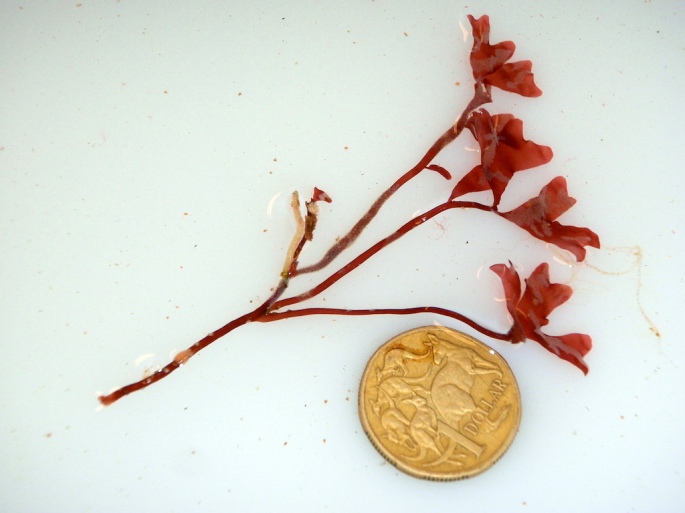Thalli typically range from 6-25 cm in height, the small crustose holdfasts bearing one or more terete branched or unbranched stipes that produce one or more loosely dichotomous blades with cuneate bases (Image A). Typically the stipe accounts for 70-90 % of the height of each axis with the blades being subordinate in this regard (Image A). Blades 300-350 µm thick in transverse section (Image B). Medulla pseudoparenchymatous with cells variable in size throughout (20-80 µm in the middle portions, typically isodiametric in shape), but gradually reducing in size toward the 2-4 layers of weakly anticlinal outer cortex with the terminal cells typically longer than wide (Image B). Stipes terete to slightly compressed, reaching 1.5 mm in diameter, the central medullary cells variable in size (7-50 µm), but gradually reducing in size to the thick anticlinal cortex (Image C). This species has an alternation of isomorphic generations. On the gametophyte the cystocarps are stalked and produced along the terete sections of the stipe and the narrow basal regions of the blades (Image D). The tetrasporophyte produces tetrasporangia in darkened raised sori that are highly distinctive (Image E).
We have genetically verified records from RI to NL (Island), as well as Norway, growing on rock from mid intertidal pools, low intertidal to subtidal (14 m). Some vegetative individuals are difficult to discern from Coccotylus truncatus (Pallas) Wynne & Heine and, especially, Coccotylus brodiei (Turner) Kützing, both of which typically have shorter stipes relative to the overall length of the axes (<70 %). Coccotylus spp. are also highly distinctive when reproductive owing to their production of carpotetrasporangia in cystocarps typically borne terminally on the blades. Definitive identification for vegetative individuals may require molecular work (Le Gall & Saunders 2010). This species can be highly variable in morphology, some of which is recorded in the BOLD taxonomy browser. Although a second species of Phyllophora has been listed for our flora (Mathieson & Dawes 2017), we have been unable to provide supporting genetic evidence.
 Image A. Vegetative specimen collected at Kleppesjoen, Norway, subtidal (10 m) (GWS040691).
Image A. Vegetative specimen collected at Kleppesjoen, Norway, subtidal (10 m) (GWS040691).
 Image B. Transverse section of the terminal bladed portion of a subtidal (3 m) individual from Campobello Island, NB (GWS013856; rehydrated from press; aniline blue stained).
Image B. Transverse section of the terminal bladed portion of a subtidal (3 m) individual from Campobello Island, NB (GWS013856; rehydrated from press; aniline blue stained).
 Image C. Transverse section of the terete stipe portion of a subtidal (3 m) individual from Campobello Island, NB (GWS013856; rehydrated from press; aniline blue stained).
Image C. Transverse section of the terete stipe portion of a subtidal (3 m) individual from Campobello Island, NB (GWS013856; rehydrated from press; aniline blue stained).
 Image D. Close-up of the stalked cystocarps typically derived from the stipe portions of a subtidal individual from St. Davids, NL (GWS007340; press). Scale = mm ruler.
Image D. Close-up of the stalked cystocarps typically derived from the stipe portions of a subtidal individual from St. Davids, NL (GWS007340; press). Scale = mm ruler.
 Image E. Close-up of the raised and dark tetrasporangial sori on the bladed portions of a subtidal individual from Pomquet, NS (GWS003511; press). Scale = mm ruler.
Image E. Close-up of the raised and dark tetrasporangial sori on the bladed portions of a subtidal individual from Pomquet, NS (GWS003511; press). Scale = mm ruler.
